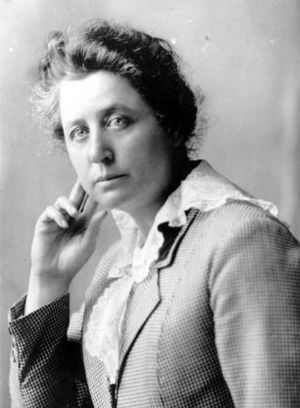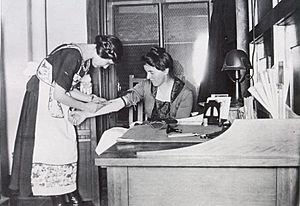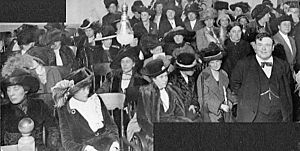Marie Equi facts for kids
Quick facts for kids
Marie Equi
|
|
|---|---|
 |
|
| Born |
Marie Diana Equi
April 7, 1872 |
| Died | July 13, 1952 (aged 80) Portland, Oregon, U.S.
|
| Occupation | Physician |
Marie Equi (April 7, 1872 – July 13, 1952) was an early American doctor. She was known for helping working-class and poor patients. Marie Equi also became a political activist. She worked for important changes like women getting the right to vote and an eight-hour workday. After a workers' strike in 1913, she became more involved with radical labor movements.
Marie Equi had a long-term partner, Harriet Frances Speckart. Together, they adopted a child and raised her. This was an early example of a different kind of family in the United States. Marie Equi faced challenges because of her political beliefs and her family life. In 1918, she was found guilty of speaking against the U.S. joining World War I. She was sent to San Quentin State Prison for a short time.
Contents
Marie Equi's Early Life
Marie Equi was born in New Bedford, Massachusetts. Her father was an immigrant from Italy, and her mother was an immigrant from Ireland. She was the fifth of many children in a working-class family. New Bedford was once a big whaling city. During Marie's childhood, it became a major center for making textiles. She went to New Bedford High School for one year. Then she left school to work in a textile factory to support herself. In 1892, Marie Equi moved to Oregon. She joined her high school friend, Bessie Holcomb, on a homestead near the Columbia River.
Starting a New Life and Studying Medicine
Marie Equi and Bessie Holcomb lived together in a small house. It was on some rocky land outside The Dalles, Oregon. In 1893, Marie Equi became known for standing up for what was right. A local newspaper reported a big event in town. Marie Equi confronted Reverend Orson D. Taylor. He was a land developer and a school superintendent. Taylor had not paid Bessie Holcomb her full salary for teaching. Marie Equi was angry about how her friend was treated. She used a horsewhip on Taylor when he tried to get away. Many people in The Dalles thought Taylor was dishonest. They cheered Marie Equi's actions. This event showed the public Marie Equi's strong sense of justice.
In 1897, Marie Equi moved to San Francisco, California. There, she began to study medicine. She took classes at two different medical colleges. Later, she moved to Portland, Oregon without Bessie Holcomb. She finished her medical studies at the University of Oregon Medical Department in 1903.
After the terrible 1906 San Francisco earthquake and fire, Marie Equi helped people. She joined other doctors and nurses to give medical care to those affected. The United States Army praised her for her brave work.
Medical Work and Helping Others
Marie Equi became one of the first 60 women doctors in Oregon. In 1905, she opened her own medical practice in Portland. She focused on the health of women and children. Her work during the 1906 San Francisco earthquake made her well-known. This disaster caused many deaths and was one of the biggest natural events of its kind. At that time, the government was not ready to provide so much help. Marie Equi's brave volunteer work was praised by California's Governor and San Francisco's Mayor. The U.S. Army even gave her a medal.
During the Progressive Era (around 1895 to 1920), Oregon made many civic and political changes. These changes became an example for the rest of the country. They included ways for citizens to propose laws and remove elected officials. Marie Equi worked hard to help women get the right to vote in Oregon. She celebrated when women won this right in 1912.
Becoming a Radical Activist
In 1913, Marie Equi visited a strike by cannery workers in Portland. These workers, mostly women, were protesting bad working conditions. They also protested uncertain work hours and very low wages. When Socialists and members of the Industrial Workers of the World (IWW) joined the strike, it grew. It then included the right to speak freely. Marie Equi joined the protest and became a leader. This was partly because she was a respected doctor.
After days of protesting, the police moved in on the strikers. Marie Equi was hit by an officer. This happened after she saw a pregnant woman being pulled away by the police. The strike ended a few days later, but the workers did not get what they wanted. For Marie Equi, seeing the police violence changed her. She became more radical in her beliefs.
Marie Equi became an important voice during Portland's unemployment crisis in 1913-1914. She marched with jobless men and demanded better working conditions. She also supported the IWW's efforts for free speech. She called herself a Radical Socialist and an anarchist. She worked closely with the IWW.
Speaking Out Against War
As the U.S. got closer to joining World War I, Marie Equi spoke out. She believed the war was mostly about rich people making money. She thought it was also about the government wanting more power. Big parades were held in U.S. cities in 1915 and 1916 to prepare for war. Portland became very nationalistic. Marie Equi felt more like an outsider. She protested a pre-war parade in downtown Portland. She held a sign that said, "Prepare to die, workingmen, JP Morgan & Co. want preparedness for profit." Others in the march attacked her, and she was arrested.
Marie Equi kept protesting after the U.S. entered the war in 1917. The U.S. government thought Marie Equi was a danger to the country. She was charged and found guilty of sedition under a new law called the Espionage Act. Marie Equi tried to appeal her case, but her appeals were rejected. Just before she was sent to prison, President Woodrow Wilson reduced her three-year sentence to one year and a day.
Marie Equi went to San Quentin State Prison in California. She started her time there on October 19, 1920. She was 48 years old. She was the only "political" prisoner among the women there. Marie Equi's health suffered in prison. She had problems with tuberculosis, which she had since childhood. She tried to stay positive with support from visitors and letters. She hoped for an early release. Marie Equi left San Quentin on August 9, 1921. Her sentence was shortened because of good behavior. She had served almost ten months.
Later Life
After the war, Americans tried to forget the difficult years. But they became very afraid of radicals and communists. This time was known as the "Red Scare." Marie Equi returned to public life. Many of her political friends were in prison or limited in their protest activities. Marie Equi went back to her medical practice.
For many years, between 1926 and 1936, Marie Equi invited the IWW leader Elizabeth Gurley Flynn to live with her. Flynn helped care for Marie Equi's daughter. Flynn had health problems, including being very tired and feeling sad from political challenges. Marie Equi, Flynn, and Marie Equi's daughter lived together in Portland. In 1930, Marie Equi had a heart attack. She sold her medical practice and asked Flynn to help her for several more years. Later, Flynn moved back East and continued her work. She became a national leader of the Communist Party USA.
Marie Equi lived a quieter life after Flynn left and her daughter grew up. Radical and labor leaders still respected her for her courage and kindness. Some of them visited her at her home.
In 1950, Marie Equi broke her hip in a fall. She spent a year in a hospital in Portland. Then she moved to a nursing home near Gresham. She passed away at Fairlawn Hospital on July 13, 1952, at 80 years old. Newspapers across the country, including the New York Times, wrote about her death. Her activist friend Julia Ruuttila said Marie Equi was "a woman of passion and conviction (and) a real friend of the have-nots of this world." She is buried next to Harriet Speckart in Portland, Oregon.
In August 2019, Marie Equi was honored. She was inducted into the Rainbow Honor Walk in San Francisco's Castro neighborhood. This "walk of fame" recognizes LGBTQ people who have made important contributions.
Images for kids
See also
 In Spanish: Marie Equi para niños
In Spanish: Marie Equi para niños




